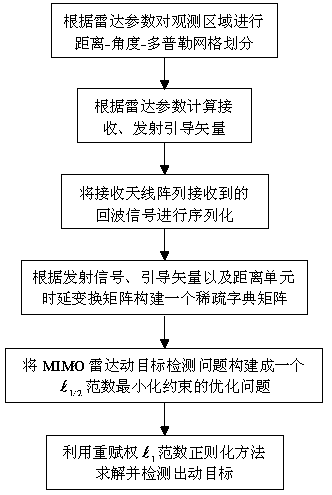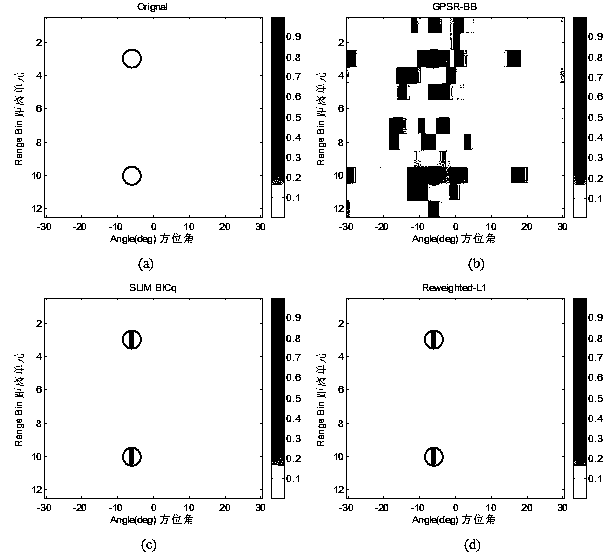Non-convex optimization based MIMO radar moving object detection method
A moving target detection, non-convex optimization technology, applied in measurement devices, radio wave measurement systems, radio wave reflection/re-radiation and other directions, can solve problems such as non-deterministic polynomial difficulties, large gaps, and low resolution
- Summary
- Abstract
- Description
- Claims
- Application Information
AI Technical Summary
Problems solved by technology
Method used
Image
Examples
Embodiment 1
[0093] Simulation of detection performance comparison in sparse target scenarios:
[0094] Assuming that the signal-to-noise ratio is SNR=20dB, two moving targets are set in the observation scene, which are respectively located in the third and tenth distance units. Puler frequency shift, such as figure 2 As shown in (a), the position of the real target is represented by "o" in the imaging map.
[0095]MIMO radar transmission waveform is a literature [He Hao, Stoica Peti-e, Li Jian.Designing Unimodular Sequence Sets With Good Correlations—Including an Application to MIMO Radar[J].IEEE Transactions on Signal Processing,2009,57(11):4391 -4405] uses the CAN method to design the transmit signal waveform.
[0096] The present invention, the GPSR-BB solution algorithm based on the convex optimization problem and the literature [Tan Xing, Roberts W.T.Jr., Li Jian, Stoica Peti-e..Sparse Learning via Iterative Minimization With Application to MIMO Radar Imaging[J] are adopted respec...
Embodiment 2
[0099] Simulation of detection performance comparison in the case of dense targets:
[0100] Under the same experimental parameters and conditions as in Example 1, 24 targets are randomly distributed in the observation scene, all of which have a Doppler frequency shift of 5°, and their positions are distributed as follows Figure 4 Shown in (a). Utilize the present invention, utilize GPSR-BB method and SLIM method to carry out simulation comparison respectively, simulation result is as follows Figure 4 shown. It can be seen that in the case of dense targets, the present invention can accurately detect the position of the target, and the SLIM method can detect most of the target positions, but the GPSR-BB method cannot accurately detect the target.
[0101] In order to verify the Doppler frequency shift resolution of the detection method, when the azimuth angle is 8°, the present invention, the GPSR-BB method and the SLIM method are used to carry out simulation comparisons r...
PUM
 Login to View More
Login to View More Abstract
Description
Claims
Application Information
 Login to View More
Login to View More - R&D
- Intellectual Property
- Life Sciences
- Materials
- Tech Scout
- Unparalleled Data Quality
- Higher Quality Content
- 60% Fewer Hallucinations
Browse by: Latest US Patents, China's latest patents, Technical Efficacy Thesaurus, Application Domain, Technology Topic, Popular Technical Reports.
© 2025 PatSnap. All rights reserved.Legal|Privacy policy|Modern Slavery Act Transparency Statement|Sitemap|About US| Contact US: help@patsnap.com



